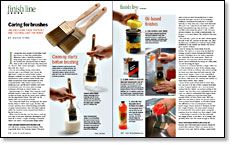Caring for Brushes
Use and clean them properly, and they will last for years
Synopsis: Cleaning brushes is a chore that few people look forward to, but it isn’t all that complicated. David Sorg explains what to do even before you use the brush to make cleanup easier. He explains the best techniques for cleaning for both oil- and water-based finishes.
It seems that most people would rather wash their house cat than their paintbrushes. Whenever I give a finishing workshop, I bring along some paint stripper to try to save the brushes that participants haul in; they’re often as stiff as the last board they were used on. Oh sure, their owners apologize… maybe blame their kids. But I know.
You can start making cleanup easier before you ever open a can of finish. First, choose the right brush. I rarely use natural-bristle brushes anymore. Synthetics are easier to clean, and several manufacturers make synthetic-bristle brushes that apply oil-based and water-based finishes as well as natural bristles. I like Purdy’s Syntox (www. purdycorp.com) and Wooster’s UltraPro Soft (www. woosterbrush.com). Of course, these cleaning techniques will work on natural bristles, too.
Remembering a few things when using the brush will help when it comes time to clean it. Before it touches the finish, dip the dry brush about halfway into the appropriate solvent. This will coat the bristles with solvent instead of finish.
Try to keep the finish from creeping into the metal ferrule, where it will be hard to get out later. This is easier said than done when brushing undersides or upper vertical surfaces. Start with these surfaces before the brush becomes saturated with finish, or flip the work over.
When done for the day, take the time to wash up, or at least to put your brush into hibernation. Don’t head off to watch a couple of innings of baseball before you clean; it will just make things harder.
Clean oil-based finishes after the final coat
Let’s talk about cleaning oil-based finishes. (This is generally where the moaning begins.) The good news is that you don’t necessarily have to clean the brush each time you use it. If I’m brushing a traditional, multi-layered varnish that is recoated each day or every other day, I don’t wash the brush after each coat. I wipe the excess finish out of the brush with a lint-free rag, then store it in a coffee can filled with solvent (see photo 1, left). For most oil-based finishes, the solvent is mineral spirits. For lacquer, it is lacquer thinner. The method is the same for both.
The next day, I press out the extra solvent against the side of the can, and put on the next coat. After the final coat, you’ll have to wash the brush; if left indefinitely in the solvent, the bristles will start to grow crystals of finish.
Start by wiping the excess finish from the bristles. The object is to carry away the finish by running as much solvent through the bristles as possible. Flushing it down the sink is expensive and unfriendly to the environment. There’s an alternative: You can reuse solvent and lacquer thinner almost indefinitely by letting the solids settle out and decanting the liquid.
From Fine Woodworking #180
For the full article, download the PDF below:
Fine Woodworking Recommended Products

Double Sided Tape

Olfa Knife

Odie's Oil






















Log in or create an account to post a comment.
Sign up Log in